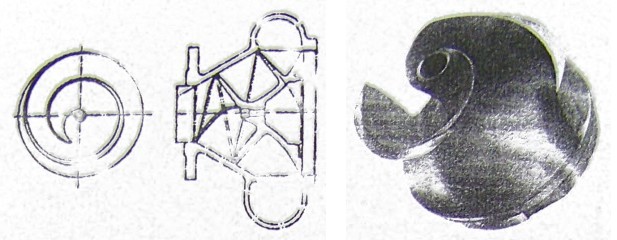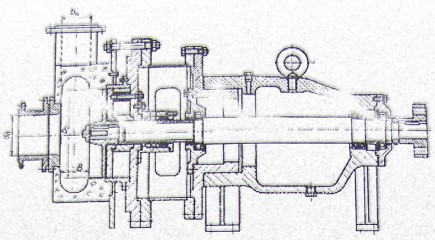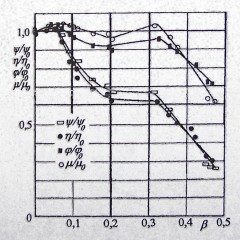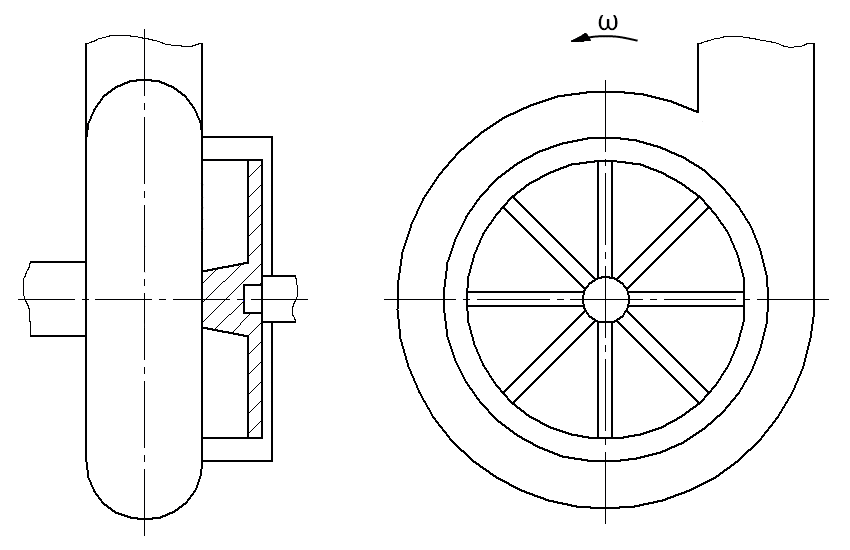Abstract on final theme of master's work
The content:
2. The purposes and the problems put in work
1. A theme urgency
The research theme is actual. The requirement for the reliable and simple pump equipment for transportation gas-liquids mixes (GLM) is available in variety of industries: oil-extracting, chemical, medical, food, overworking etc. The pump equipment most used at present is the pump equipment of a hydrodynamic principle of action, therefore the decision of a problem of a choice from all variety of the dynamic pumps working on GLM, optimum plays an important role for consumers of the given pump equipment. Carrying out of the research directed on the decision of the considered problem, is expedient and economically justified.
2. The purposes and the problems put in work
The work purpose is studying of working process of radial pumps (RP) about one- and two boards driving wheels (РК) (fig. 1), working on GLM. And also creation of recommendations for choice the most comprehensible pump equipment for the set working conditions.

a) b)
b)
For purpose achievement following problems are formulated:
- the analysis of dynamic pumps on GLM in a wide range of rapidity and an estimation of influence of a design of their flowing parts for steady work on GLM;
- definition of possibility of application RP, having DW with small number of blades (1,2) in the conditions of their work on GLM;
- estimation of influence of geometry of a flowing part one blades DW on characteristics RP, working on GLM;
- definition of a picture of current GLM in flowing part RP about one- and two blades DW with use of methods of numerical modeling;
- the analysis of influence of bosoms one- and two blades DW RP for steady work of the pump on GLM.
3. The review of researches on studying of influence of free gas on characteristics of the dynamic pumps working on GLM
Now there is a set of works on studying of influence of size gas content for work of the dynamic pumps which are pumping over bubble-point suspensions. However each research is strictly adhered to a concrete design of a flowing part bladed pumps. Materials of different authors have inconsistent enough character that as a result does not allow to receive an accurate and clear picture of the researches spent by them. Existing techniques of recalculation of characteristics of dynamic pumps from water on GLM also are fastened on a concrete design of this or that pump.
Authors of works [1-5] had been in detail investigated a current in pump channels.
Бажайкиным С.Г. [6-8] taking into account phase transitions researches of change of power characteristics RP are conducted in channels RK.
Works [9-12], are directed on studying of influence of a gas phase on character of a current and characteristic RP.
Work [14] is devoted calculation of current GLM in pumps and separators.
In work as [13] author results of the visualisation of working process spent by him in flowing part FVP of type «Turo» (fig. 2) are brought at his work on a water air mix. During this work 5 places of formation and a congestion of air vials (fig. 4) have been established.



Fig. 4. Zones of a congestion of vials of air in flowing part FVP of type «Turo» at his work on GLM.
(animation: volume - 22,4 Kb; size - 850х550; quantity of shots - 9; quantity of cycles of repetition - 5)The conclusion
Thanks to the spent review of the literature it has been established that foreign manufacturers insist that by the most effective in the plan not clogs and simplicity of a design in this range can be applied RP, having DW with small number of blades.
It is known that RP traditional constructive schemes steadily work, when the size critical volume gas content does not exceed 10 - 15 % from total amount of a pumped over mix. According to the data received during the literary review, RP, having DW with small number of blades, are effective at much bigger volumes of gas in a pumped over mix.
The list of references
- Конструкции центробежных насосов для подачи жидкостей с высоким газосодержанием / ВЦП. – № М – 16078. – Пер. ст. Kosmowski I. из журн.: British Pump Manufacturers Association. Technical Conference. – Cambridgs. – 1983. – № 8. – р. 159-169.
- Анализ условий работы центробежного насоса, перекачивающего жидкости, содержащие газ. / БелНИИНТИ. № 542/3. – Пер. ст. Kosmowski I., Steinhheimer К. – из материалов конф.: Conference on Fluid Machinery (7, 1983, Budapest) Proceeding., Vol. 1, – р. 458-466.
- Kosmowski I. Behaviour of centrifugal pumps when conveying gas entrained liquids. 7-th Technical Conference of the British Pump Manufacturers' Association 31 st March-Developing Needs, – р. 283-291.
- Kosmowski J., Stephan R., Wompner V. Einflus den Homogenisierung auf die Forderung gesbeladener Flussigkeiten // Pumpen – und Verdichterinf, 1986. №2. – p. – 30-42.
- Режим течения жидкости и газа в ротационных системах / ГП НТВ. № 81/46903. – Пер. ст. Kosmowski J. из журн.: Pumpen – und Verdichterinf, 1980, №1. – p. 34-38.
- Бажайкин С.Г. и др. Об изменениях характеристик центробежного насоса, работающего на крупнодисперсной газожидкостной смеси // Тр. ВНИИ по сбору, подготовке и транспортировке нефти и нефтепродуктов – 1976. Вып. 17. – с. 199-206.
- Бажайкин С.Г. Исследование влияния свободного газа на работу центробежного насоса при перекачке газожидкостных смесей по промысловым трубопроводам: Автореф. дисс. канд. техн. наук. – Уфа, 1980. – 20 с.
- Бажайкин С.Г. Расчет напорных характеристик центробежных насосов с учетом фазовых переходов в каналах рабочего колеса 9 Ежегодный Международный конгресс «Новые высокие технологии для газовой, нефтяной промышленности, энергетики и связи». Уфа, 1999. Тезисы стендовых докладов. Уфа: Транстэк, 1999. – с. 10-12.
- Ляпков П.Д. О формах течения водовоздушных смесей в каналах рабочих органов центробежного насоса // Химическое и нефтяное машиностроение, 1968, № 10. – с. 54-62.
- Шарипов А.Г., Минигазимов М.Г. Исследование влияния газа на характеристику погружного центробежного насоса ЭЦН5-130-600 // Нефтяное хозяйство, 1969, № 11. – с. 27-32.
- Ляпков П.Д. Игоревский В.И. О массообмене в погружном центробежном насосе // Нефтепромысловое дело, ВНИИОЭНГ, 1976, № 11. - с. 12- 17.
- Ляпков П.Д. Игоревский В.И. Учет влияния газовой фазы на напорно-расходную характеристику многоступенчатого центробежного наоса // Всесоюзная научно-техническая конференция по гидромашиностроению «Проблемы и направления развития гидромашиностроения», Сумы, 1978. Тезисы докладов. Москва, ХОЗУ Минхиммаш 1978. – с. 92-95.
- Сапожников СВ. Учет газовой составляющей среды при определении конструкции и рабочей характеристики ЦН: Дисс. канд. техн. наук: 05.05.17. – Сумы, 2002. – 206 с.
- Трулев А.В. Расчет течения двухкомпонентных смесей в насосах и газосепараторах // Химическое и нефтяное машиностроение, 2000, № 8. – с. 36-38.
- Евтушенко А.А., Сапожников СВ. Основные положения методики пересчета ЦН с воды на газожидкостную смесь // Вісник СумДу, № 2 (10), 1998. – с. 71-75.



